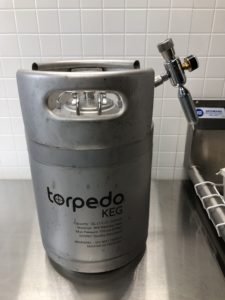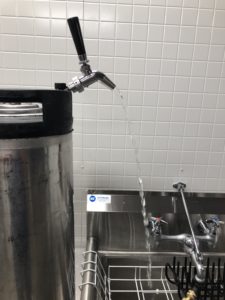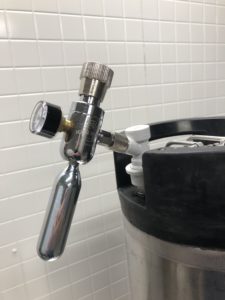
Hands On Review: Mini CO2 Regulator from MoreBeer – Serve Your Beer On The Go
A Hands on review of this Mini CO2 Regulator via MoreBeer
MoreBeer bills this as an affordable, easy to transport CO2 regulator that works with both ball lock and pin lock disconnects.
About, from MoreBeer: “Be the hit of the next party, tail gater, softball game, etc when you show up with a keg of your homebrew! This compact, affordable CO2 regulator allows you to leave your heavy, bulky CO2 system at home. Use this small, portable, adjustable regulator along with a threaded 16g CO2 cartridge (not included) to pour kegged beer anywhere! Depending on your style of keg you will either need a ball-lock or pin-lock quick disconnect.”
Why Use a Mini CO2 Regulator?
Portable Serving: As an on-the-go regulator.
Backup – I’m out of CO2 and I want to pour a beer! Use as a backup if your main CO2 tank runs out. Swap out the CO2 line for this regulator and you’ve got a temporary solution to keep you up and going until you can get more CO2.
Serve Beers at Alternate Carbonation Levels: This regulator goes up to 30 PSI. That’s enough to serve higher carbonation beers like Hefeweizens and Belgians. If you don’t have a dual or triple pressure setup, you could use this regulator to serve beers at higher pressures. You could carbonate using your existing regulator (and full size tank) or naturally carbonate with priming sugar. After the beer is completely carbonated, use this to serve at the higher pressure.
MKII Regulator CO2 Charger Review
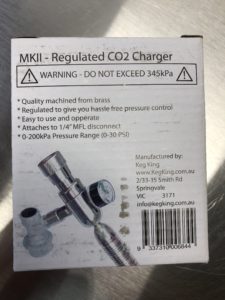 A look at the box. Reads: Quality machined from brass, Regulated to give you hassle free pressure control. Easy to use and operate. Attaches to 1/4″ MFL disconnect. 0-200kPA Pressure Range (0 to 30 PSI). Warning – Do Not exceed 345kPa.
A look at the box. Reads: Quality machined from brass, Regulated to give you hassle free pressure control. Easy to use and operate. Attaches to 1/4″ MFL disconnect. 0-200kPA Pressure Range (0 to 30 PSI). Warning – Do Not exceed 345kPa.
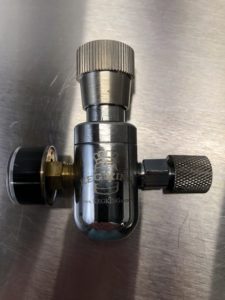 A look at the regulator. Adjustment knob is on top, gauge is on the left, MFL connection (for EITHER ball or pin lock kegs (with 1/4″ flare threads) on right.
A look at the regulator. Adjustment knob is on top, gauge is on the left, MFL connection (for EITHER ball or pin lock kegs (with 1/4″ flare threads) on right.
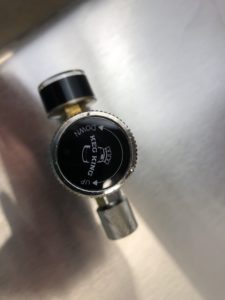 Top down view. Displays a cool looking Keg King Logo along with clear markings for up and down.
Top down view. Displays a cool looking Keg King Logo along with clear markings for up and down.
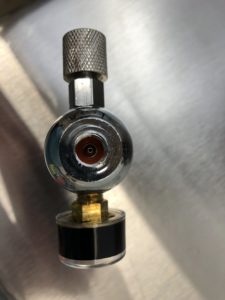 A look at the female flare threads on this mini regulator. These are 1/4″ flare threads that work with both ball lock and pin lock QDs
A look at the female flare threads on this mini regulator. These are 1/4″ flare threads that work with both ball lock and pin lock QDs
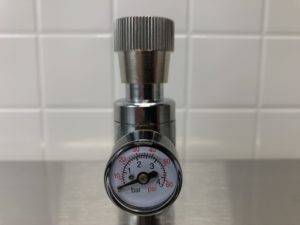 A look at the regulator dial. This has a stated range of 0 to 30 PSI. The regulator dial reads 0 to 60 PSI.
A look at the regulator dial. This has a stated range of 0 to 30 PSI. The regulator dial reads 0 to 60 PSI.
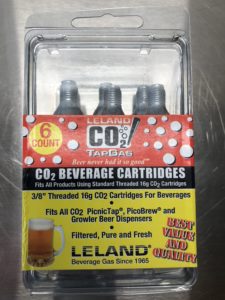 This uses 3/8″ threaded 16 gram CO2 cartridges. I used Leland brand that are rated for beverages. SEE: 16 g Threaded CO2 Cartridge – 6 Count KEG993
This uses 3/8″ threaded 16 gram CO2 cartridges. I used Leland brand that are rated for beverages. SEE: 16 g Threaded CO2 Cartridge – 6 Count KEG993
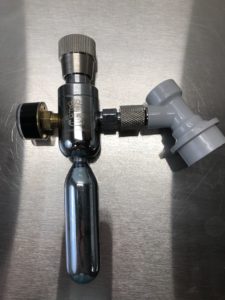 The mini regulator complete with CO2 cartridge and a ball keg QD installed
The mini regulator complete with CO2 cartridge and a ball keg QD installed
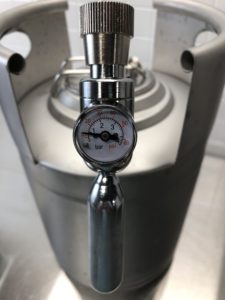 Installed on a 2.5 gallon Torpedo Ball Lock Keg
Installed on a 2.5 gallon Torpedo Ball Lock Keg
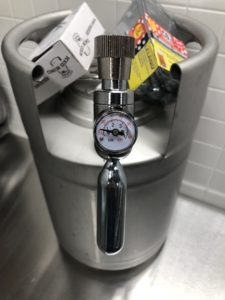 To check for leaks, I pressurized this and let it sit. It held rock steady for four days.
To check for leaks, I pressurized this and let it sit. It held rock steady for four days.
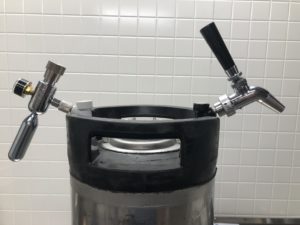 Installed on a Cornelius Keg with forward sealing stainless steel Intertap Faucet. You could also use a picnic tap/cobra faucet. This adapter makes the serving side of this setup possible. It threads onto most faucets and onto 1/4″ flare QDs, both ball lock and pin lock.
Installed on a Cornelius Keg with forward sealing stainless steel Intertap Faucet. You could also use a picnic tap/cobra faucet. This adapter makes the serving side of this setup possible. It threads onto most faucets and onto 1/4″ flare QDs, both ball lock and pin lock.
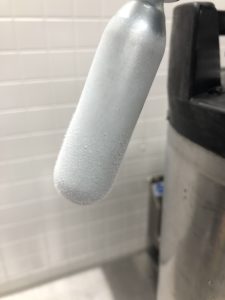 I noticed that the CO2 cartridge had a tendency to frost over when serving large amounts. It didn’t inhibit serving and, I think, this would rarely occur in actual use because people don’t typically pull a gallon at a time. I’m including this mainly because I think it’s a neat photo. Click to enlarge.
I noticed that the CO2 cartridge had a tendency to frost over when serving large amounts. It didn’t inhibit serving and, I think, this would rarely occur in actual use because people don’t typically pull a gallon at a time. I’m including this mainly because I think it’s a neat photo. Click to enlarge.
The regulator installed on a ball lock keg
16 gram CO2 Cartridge Estimations and Tip
How many 16 gram cartridges does it take to serve 5 gallons of beer? About 3. That’s for a full 5 gallons. I used a serving pressure of 6 PSI for this estimate. If you bump it up to 8 PSI, The estimate figures to about 3.5 cartridges. These are only estimates and will depend on a number of factors including temperature. If your beer warms up a bit while serving, you’ll use less CO2.
Cartridge Saving Tip: Consider adding some more CO2 to your keg’s headspace, prior to leaving home, from your kegerator’s CO2 tank. This will save on 16 gram cartridges. Of course you’ll want to do that within the stated limits of your keg and equipment. To prevent foaming, you’ll have to pick reasonable pressure for your setup.
Can you for carbonate using this setup and 16 gram cartridges? Yes, I estimate it would take about 6 cartridges to carbonate 5 gallons at 2.5 volumes.
Saving Partial Cartridges: Pin lock and ball lock QDs are valved. That means you should be able to save partial cartridges for future use if you leave the QD on.
Regulated Mini Regulators vs Injectors
This regulator is a… regulator. Speaking about handheld CO2 injectors (like these): Guests tend to squeeze those for fun and sport and empty cartridges in short order. You just need a couple of taps to keep pressure at an acceptable level for serving. The point is, there is some work and finesse required to use injectors. Contrast that with this regulator. This has a gauge that allows you to set the pressure right where you want it. Your beer stays at the intended pressure automatically. No expert intervention required. I would venture a guess that this will use less cartridges compared with injector type solutions.
Final Thoughts
This is a quality product that does the job it’s supposed to do. It looks great and works great. At it’s current price of around $35, it’s a great deal. Like most things at MoreBeer shipping is free with a $59 order
Resource Post: Portable Draft Beer Serving Options
More MoreBeer Reviews+Related:
More Homebrew Finds!
- Last 50 Finds!
- Top Deals – a curated list of the best deals
- Homebrew Reviews – one of the largest libraries of homebrew reviews in existence!
- Our Top Posts – tips, how-tos, resources posts and more
Also: Kegerator Tips & Gear | Keg Repair Part #s | Recent Keg Finds
Our Top Draft Resources!
Check our our Top Draft Related Resources- Commentary: Pin Lock Keg Pricing and Availability
- Check Your CO2 Regulator for Leaks!
- How to get a keg ready for first use? New Keg Cleaning and Prep
- Portable Draft Beer Serving Options!
- Pin Lock Keg Pricing and Availability
- The Most Difficult Spot to Check for CO2 Leaks
- Keg O-Ring Materials Selection! – EPDM, Silicone and Buna-N?
- Why Do I Have Bubbles in My Beer Line? Diagnosing and Fixing Kegerator Foam Problems
- Five Benefits of Using Corny Kegs As Fermenters
- Rebuilding & Reconditioning Homebrew Kegs!
- Food Safe Replacement Keg O-Rings in Bulk
- Hands on Review: Kegland DuoTight Fittings & EVABarrier Tubing!
- Why Won’t My Beer Carbonate? Fixing Draft Beer Carbonation Problems
- What Does a Flow Control Faucet Do?
- Upgrade Your Kegerator – 6 Improvements!
- Serve Homebrew on Any Kegerator & Convert Commercial Kegerator to Homebrew
- Tips and Gear for Growler Filling
- What’s the Difference Between Ball Lock Kegs and Pin Lock Kegs?
- Checking for Draft System CO2 Leaks – Using The Pressure Gauge Method
- Tip: Consider Oetiker Stepless Clamps for Kegerator Gas and Beer Lines
- Hands On Review: Inkbird ITC-308 Dual Stage Temperature Controller +WiFi Version
- Universal Poppets Tips and Tricks!
- Convert Your Mark II Keg & Carboy Washer to a Recirculating Draft Line Cleaning Pump!
- Step by Step: Finding and Fixing Keg CO2 Leaks
- Kegerator Temperature Probe Placement – To Immerse or Not To Immerse? – three tests to determine optimal pla…
- Kegerator Beer Line Temperatures & Reducing Foam with a Recirculating Fan
- Kegging CO2 Use Estimations and Calculations
- Balancing Your Kegerator Draft System
- Building a Simple Ball Lock Draft Line Flushing Setup
- Build a Recirculating Draft Line Cleaning Pump
- Home Brew Keg Roundup – New & Used, 5 and 2.5 Gallon & More!
- Damp Kegerator? Fix Kegerator Condensation
- Homebrew Temp Controller Roundup! – Kegerator and Fermentation – concepts, applications and models
- Bulk Keg Orings and Keg Parts Reference
This post contains affiliate links. We may make a commission when you use our links. This will never cost you extra. Thank you for supporting Homebrew Finds!
morebeerMake sure the components you use are compatible and rated for your intended application. Contact manufacturer with questions about suitability or a specific application. Always read and follow manufacturer directions. review:morebeerminireg tag:tpr
